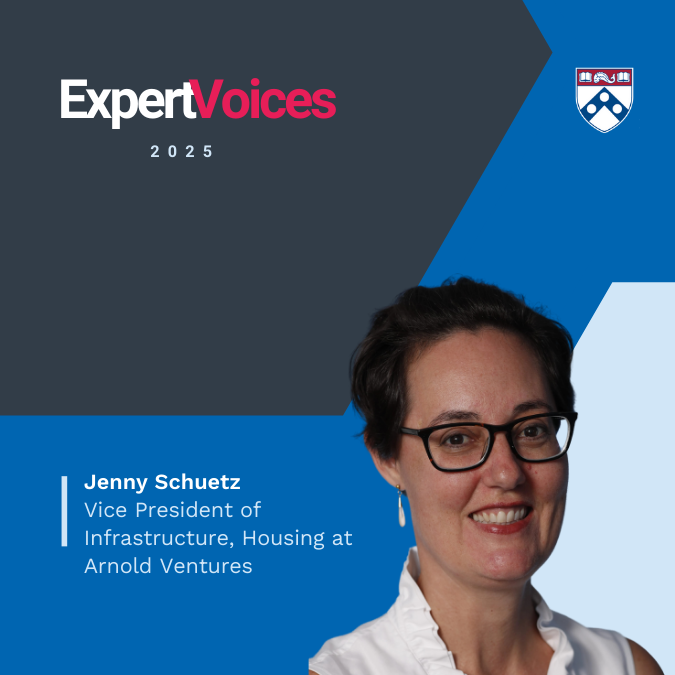Co-Directors Letter

Annually, we at the Penn Institute for Urban Research engage a globally recognized group of experts to address a pressing urban challenge. This year, we asked leading voices in housing policy, urban planning, and finance to share their perspectives on a critical question: What bold actions or structural reforms are needed to ensure access to sustainable and affordable housing, particularly to expand supply? What are the effective strategies that national and subnational governments can use to address this challenge?
As we move into 2025, it is clear that the affordable housing crisis will only intensify. In the wake of economic uncertainty and political shifts, the challenges facing housing markets in the U.S. and globally are growing ever more complex.
We are pleased to present perspectives from 13 leading experts on affordable housing:
- Vidhi Anderson | Vice President of Development at Human Good
- Angel Cardenas | Urban Development and Creative Cities Manager at CAF – Development Bank of Latin America
- Henry Cisneros | Co-Founder and Chairman of American Triple I
- Lance Freeman | Penn Integrates Knowledge Professor of City and Regional Planning and Sociology at the University of Pennsylvania
- Laurie Goodman | Founder of the Housing Finance Policy Center at the Urban Institute
- Julia Gordon | Former Assistant Secretary for Housing and Federal Housing Commissioner at the U.S. Department of Housing and Urban Development
- Ben Keys | Rowan Family Foundation Professor of Real Estate and Finance at the University of Pennsylvania’s Wharton School
- John Landis | Professor Emeritus of City Planning at the University of Pennsylvania's Weitzman School of Design
- Marc Morial | President and CEO of the National Urban League
- Jonathan Reckford | Chief Executive Officer of Habitat for Humanity International
- Vincent Reina | Professor of City and Regional Planning at the University of Pennsylvania Stuart Weitzman School of Design
- Anacláudia Rossbach | Executive Director of UN-Habitat and
- Jenny Schuetz | Vice President of Infrastructure, Housing at Arnold Ventures.
Their insights offer a range of strategies—both bold and pragmatic—that could mitigate the looming challenges, expand housing supply, and ensure that affordable housing remains within reach for those who need it most.
Four central themes emerge from our experts’ responses:
- Breaking Down Barriers to Supply-Side Affordability
- Enhancing Financing Mechanisms for Affordability
- Prioritizing Sustainability and Equity and
- Collaborating and Leading Boldly.
They agree that addressing the housing crisis will require an “all hands on deck” approach, with coordinated actions across all levels of government, the private sector, and civil society.
Each of the solutions has transformative potential. By aligning efforts, committing to bold reforms, and working collaboratively, we can make affordable and sustainable housing a reality for all, supporting the broader goals of equity and urban development.
With the potential for further stress on housing systems in the coming year, the need for innovation and leadership has never been more urgent. We are grateful to our contributors for considering these critical issues and solutions and look forward to advancing the conversation.
- Eugénie Birch and Susan Wachter, Co-Directors, Penn Institute for Urban Research
Vidhi Anderson
Housing affordability is a complex issue that requires the federal, state, and local governments as well as the private sector to work together to create policy reforms and streamline processes to increase the supply of affordable housing. What makes housing expensive and unaffordable is the cost to build it and the cost to manage it. Let’s break this down. For a developer to build housing that’s affordable, it needs to be built in a municipality that encourages and supports development, where the land use policies incentivize developers, where there is a fast track through the permitting process, and where land is available at reasonable costs with favorable zoning and tax breaks. As we know, time is money, and the shorter this approval process, the less the end user will be burdened by the predevelopment costs borne by the developer upfront. Reducing this regulatory and bureaucratic web largely falls on local municipal governments.
With approvals in hand, the developer needs to work with contractors to negotiate ever-increasing construction costs. The increase in costs is a result of a multitude of factors including supply chain issues leading to delays, lack of domestic manufacturing, unavailability of material, increases in tariffs and a shrinking workforce. Construction materials come from all parts of the world and are vulnerable to geopolitical dynamics that are far bigger than a developer or a regional development community’s ability to change. This is where the federal government can work on trade policies and tariffs and create an environment that increases domestic manufacturing. States can increase development funding for projects, especially those that target lower- or middle-income families and seniors.
For their part, the construction industry needs to explore modular construction and other innovations in construction technology to bring more efficiency into the building assembly process, making it less weather-dependent and building to exact standards under controlled conditions and in a shorter timeframe. This falls on the private sector but needs a less regulated environment for easier import of timber and other material nationally and internationally.
High insurance premiums and interest rates add significant costs to the development budgets. Annual premium increases of 30% or more are not sustainable and the cost passes through to the end user, contributing to increasingly unaffordable housing. Interest rates have the most direct and significant impact on affordability. Is there a way to shield affordable housing lending to make it more insulated from interest rate changes?
Another way of reducing costs, both during development and operations, would be by providing grants that could support sustainable design features and help reduce added costs for the developers to provide energy efficient and climate resilient features. These will result in buildings designed to withstand the threat of climate change and reduce energy usage and utility bills. The subsidies will ensure the costs are not added to the final price tag to the end user and that they benefit from lower utility bills. Adding operating subsidies to reduce the rent burden on tenants or the cost to manage a home for a first-time home buyer are critical.
Housing creates equity; it’s a social determinant of health. Without a safe, affordable home, families cannot take care of their health and their children’s health; seniors are vulnerable. Housing is a human right. We must work hard to make it affordable.
Vidhi Anderson is Vice President of Development of Human Good, a nonprofit offering affordable housing for low-income seniors ages 55 and older. In this role, she oversees both the development of new senior housing communities and the preservation of its existing portfolio on the East Coast, with the goal of creating an environment that allows seniors to age in place.
Angel Cardenas

Affordable housing is more than a basic human need—it is a foundation for economic equity, urban sustainability, and social mobility. Across Latin America, this pressing challenge is compounded by systemic barriers on both the supply and demand sides, calling for innovative and bold solutions.
Supply-Side Constraints
The high cost of urban land represents a significant hurdle, accounting for 10-30% of housing expenses in many Latin American and Caribbean nations. Speculative practices, fragmented ownership, and inefficient land use policies drive these costs even higher. Compounding the issue, regulatory frameworks often stifle development. Lengthy approval processes—sometimes requiring months or even years and multiple administrative clearances—discourage investment in housing projects. Restrictive zoning laws, such as height limitations and setback requirements, further suppress housing supply and inflate per-unit costs.
Infrastructure deficits add another layer of complexity. Insufficient utilities, inadequate transportation networks, and costly land preparation increase project expenses. Meanwhile, fragmented construction supply chains and reliance on traditional labor-intensive methods limit productivity and scale.
Demand-Side Barriers
The demand side of the equation presents equally daunting challenges. Mortgage markets vary widely across the region. While countries like Chile and Panama exhibit relatively modest market depths (30.6% and 23.1% of GDP, respectively), others, such as Colombia and Ecuador, struggle with rates below 10%. High-interest rates exacerbate this disparity, disproportionately impacting low- and middle-income households.
Labor market informality, affecting nearly half of urban workers, intensifies the affordability crisis. Excluded from formal credit systems, these workers face persistent economic marginalization and precarious housing conditions.
Transformative Pathways for Change
Overcoming housing affordability challenges in Latin America demands a multi-pronged approach targeting systemic barriers on multiple fronts.
Regulatory and Land Use Reform
Streamlining permit processes through single-window clearance systems can significantly reduce delays in housing projects. Flexible zoning regulations that encourage higher-density urban development are equally vital. Moreover, implementing land value capture mechanisms—where increases in land value due to public investment are reinvested in affordable housing—can help fund high-density developments and improve urban planning.
Innovative Financing and Partnerships
Public-private partnerships offer immense potential to accelerate the delivery of affordable housing. Mechanisms such as housing microfinance and rent-to-own schemes can bridge credit gaps, particularly for workers in the informal sector. These tools can unlock access to housing finance for those traditionally excluded from formal credit systems.
- Construction and Technological Innovation
Adopting industrialized construction methods, such as prefabrication and modular housing, can address inefficiencies in traditional supply chains and reduce costs. Skills training tailored to these innovative approaches can further enhance productivity. Achieving economies of scale through strategic investment and collaboration among stakeholders can mitigate fragmented supply chain challenges.
Strategic Infrastructure Investment
Developing comprehensive urban infrastructure plans is crucial. These plans should integrate underutilized lands into housing strategies, making them accessible and viable for development. Reforming land cadastral systems and streamlining property transaction processes can ensure equitable urban growth and better resource allocation.
Collaborative Action for Market Transformation
Addressing the housing affordability crisis requires alignment between national and regional priorities and the needs of urban residents. Policies must be inclusive, data-driven, and evidence-based, prioritizing vulnerable populations while fostering sustainable urban growth. Collaboration among stakeholders, from governments to private developers and civil society, is essential to create housing markets that promote equity and opportunity.
By drawing on regional successes and tailoring strategies to diverse local contexts, Latin America and the Caribbean can transform its housing markets. With coordinated efforts, housing affordability can evolve from a persistent challenge into an engine of social progress and economic resilience.
Angel Cardenas is the Urban Development and Creative Cities Manager at CAF – Development Bank of Latin America. An Eisenhower Fellow at Eisenhower Fellowships, Angel is a professional with over ten years of hands-on experience in strategic planning and development finance at the World Bank and CAF-Latin American Development Bank.
Henry Cisneros
One of the basic attributes of a strong nation, state, or city is that its stock of housing contributes to its overall quality of life and the underlying prosperity of its people. Its homes and residences are where its people live, raise their families, prepare for work, relax, express their spirituality, and safeguard their personal possessions. Housing is the locus for these human functions across every part of the world, within every economic system, and for every income class. Wherever housing is inadequate, unavailable, or unaffordable, people suffer. And where these shortfalls are widespread and intractable, there exists a housing crisis.
As we begin a new year and commence the term of a new president, the United States confronts a measurable and serious housing crisis. The crisis forces some people to live in unsafe and over-crowded rentals; it requires others to postpone their dreams of homeownership, denying them a key steppingstone for reaching the middle class, and it pushes others to find shelter under bridges and on city sidewalks. Today, in America, more renters are stressfully cost-burdened than ever before. Both urban and rural areas are experiencing increases in homelessness. Meanwhile, home prices have greatly outpaced incomes, such that only 10% of metro areas have ratios of home prices to incomes that indicate affordability.
I recently participated as a member of the National Housing Crisis Task Force, an effort spearheaded by the Nowak Lab at Drexel University and by Accelerator for America. It was led by several big-city mayors, a governor, and private sector leaders. Its purpose was to treat the national housing crisis like the real crisis that it is and to recommend concrete actions that are achievable, timely, and replicable. Its forty task force recommendations are designed to focus the nation on the crisis, reduce barriers to production, mobilize capital, deploy innovations on a national scale, and undergird a stronger and more durable safety net.
The following paragraphs summarize a few of the task force recommendations that can be acted upon immediately and are sorted here by the kind of action it would take to enact them:
Recommendations the President Can Initiate by Executive Order or Administrative Action
- Create a Housing Crisis Council in the White House and task the Council of Economic Advisors with creating housing production goals. This would entail creation of a multi-department council to mobilize an "all government" crisis response focused on production goals.
- Authorize an emergency no-cost disposition of surplus government land and buildings for development of affordable housing. Reducing the cost of land in the financial modeling of housing developments would make it possible to develop as many as 100,000 housing units where they are needed, according to the Lincoln Institute of Land Policy.
- Authorize Fannie Mae and Freddie Mac purchases of construction loan mezzanine debt: The government-sponsored enterprises could play a stronger role in construction lending and lower the overall cost of financing housing developments.
Recommendations the Congress Can Enact in its Upcoming Session Through the Appropriations Process
- Provide low-cost FHA and USDA debt for mixed-income housing developments to stimulate stalled housing construction, provide grants for adaptive reuse projects, and create a first loss pool for modular housing. Lower-cost debt can directly address the reduced levels of housing production. The vast number of under-utilized buildings since the pandemic could greatly add to the supply of residential units, and modular housing can be affordable.
- Provide Housing Choice vouchers to all who are eligible and provide funding to update the existing affordable housing stock. Housing is a critical element of the social safety net, and vouchers in various forms can help households pay rent, buy a home, or subsidize new developments.
- Support programs that train and place young adults in the construction trades. Technical construction career programs and apprenticeships at the high school and community college levels can generate 100,000 needed workers in the construction trades.
Recommendations the Congress Can Undertake as Legislative and Tax Priorities
- Recalibrate Housing and Urban Development (HUD) programs for more rapid housing production and scale up Department of Transportation and Department of Energy programs for housing production. Many regulations in HUD programs have not kept pace with changes on the ground in communities, such as local zoning changes that allow Auxiliary Dwelling Units. Needed housing can be built in collaboration with transit projects and educational programs.
- Streamline and expand access to low-cost financing for Housing Finance Agencies and modernize the property insurance market. FHA can streamline its risk-sharing programs with state and local HFAs to finance projects at lower interest rates. The problem of rising premiums for property insurance, liability insurance, and builders' risk insurance is a major factor in increasing home building costs and requires focused attention.
- Expand and reform the low-income housing tax credit (LIHTC) and add a new tax credit for moderate-income renters. LIHTC is one of the most important tools in the production of new affordable housing and can be strengthened by expanding the 9% credit. There is a pressing need for a credit for tax filers who are renters that would lower their rent burden and that is administratively straightforward.
These are condensed versions of just a few of the task force recommendations, but the entire list is intended to go beyond traditional federal action and to expand participation in housing production and affordability by state and local governments and private housing producers. Federal actions can set the stage with new laws and funding, but the scale of the crisis requires an explosion of housing innovation and a tidal wave of local leadership across the nation.
Our country faces an insidious crisis that is difficult for all to see or accurately gauge. For Americans who live in ample homes in nice settings, it can appear that all is well in the housing sector. But the reality of the crisis hurts the nation now and in the long run. Unequal access to stable housing, disparate homeownership rates, and the attendant continuance of generational poverty all do damage to our hopes for unity and prosperity. This task force report proves that there are actions we can and should take to produce the homes needed to put American progress within the reach of all.
Henry Cisneros is Chairman of American Triple I, an infrastructure investment firm based in New York. He founded CityView in 2003, a partner in building more than 100 communities in 13 states, building more than 7,000 homes with a total value of over $5 billion. He became the first Hispanic-American mayor of a major U.S. city, San Antonio, Texas in 1981, serving four terms. Cisneros served as Secretary of the U.S. Department of Housing and Urban Development under President Clinton and has been credited with initiating the revitalization of many of the nation’s public housing developments and with formulating policies that contributed to achieving the nation’s highest-ever homeownership rate.
Lance Freeman
The inadequacy of housing supply looms large when considering the challenge of affordable housing. The Urban Institute estimates an annual shortfall of at least 100,000 units between housing demand and the housing that is produced (Parrott and Zandi 2021). In markets for most goods, an inadequate supply, accompanied by rising prices, which surely reflects our housing market, spurs more supply. But our housing shortage persists. Why?
In many places, myriad land use regulations limit density and require lengthy approval processes, serving to increase the cost of housing and reduce how much is produced. Even in places where housing can be developed relatively densely, such as New York City, approval processes can make it difficult to see new housing developed.
Planning approval processes provide an opportunity for community input. No doubt, community input is desirable and necessary, but such input needs to occur in a predictable and systematic manner. Instead of the merits of new development being weighed on a case-by-case basis, cities need land use regulations that reflect the interests of their communities and can accommodate and anticipate likely new development.
Comprehensive planning is where communities lay out their vision for the future and establish a framework for achieving that vision. But too frequently, such comprehensive planning is out of date or fails to anticipate new development. Instead, incipient development proposals can only come to fruition after a long and expensive approval process.
With an up-to-date comprehensive plan that reflects a community’s values, more as-of-right development would occur. Developers could anticipate what type of development would be allowed and adapt their practices to meet those requirements. This would go a long way towards ensuring both the community’s values are reflected in new development, and that such development eventually occurs.
Parrott, Jim, and Mark Zandi. 2021. "Overcoming the nation’s daunting housing supply shortage." Washington, DC: Urban Institute.
Dr. Lance Freeman is a Penn Integrates Knowledge Professor of City and Regional Planning, and Sociology at the University of Pennsylvania. He has published a number of articles in refereed journals on issues related to gentrification, urban poverty, housing policy, urban sprawl, the relationship between the built environment and public health and residential segregation and is the author of several books, including There Goes the Hood: Views of Gentrification from the Ground Up, A Haven and a Hell: The Ghetto in Black America and Planning and Control of Land Development.
Laurie Goodman
The lack of supply is the single most critical issue affecting the U.S. housing market. While there is some disagreement on the extent of the shortage, it is quite considerable. Supply is somewhere between 1.5 million and 5.5 million units short of demand. The economics of supply and demand suggest that building more housing of all types drives down both home prices and rents.
Unfortunately, there is no silver bullet to fixing the housing supply shortfall in the U.S.—it is a combination of four factors:
State and local zoning restrictions
Restrictive building codes
The high costs of labor and materials, and
Financing constraints. And these constraints are especially binding on the single-family market, making it particularly hard to build affordable single-family homes.
Construction starts for multifamily units, while much lower than in the 1960s, 1970s, and early 1980s, are near the upper end of their range since the passage of the 1986 Tax Act; this Act eliminated some of the favorable tax breaks for investment property. By contrast, single-family starts are well below the levels from the 1960s through the early 2000s.
Fixing this shortage will require a myriad of actions. Here are few high potential areas on which policymakers should focus:
Manufactured housing, the most affordable type of housing, is a better-quality product now than ever before. However, less than half the number of units are being shipped than in the 1977 to 1994 period. Focusing on eliminating zoning barriers and improving financing on home-only loans would increase the use of this product.
Modular homes (homes constructed offsite and assembled onsite) constitute 3 percent of single-family production, a number that is down slightly through the decades. Permitting modular homes to be built to federal standards rather than state and local building costs would allow this product to be scaled.
Accessory Dwelling Units (ADUs) are additional dwelling units on existing lots; this may include interior structures, backyard cottages and garage conversions. California has provided a blueprint for increasing ADU construction. Beginning in 2016, California has adopted multiple pieces of legislation to make it easier for homeowners to create an ADU on their property. California has allowed ADUs as a matter of right, removed most set-back and parking restrictions, and required that standardized plans be on file; if a homeowner uses a standardized plan, no preapproval is required. The success of this program speaks for itself: in 2023, ADUs represented more than 20 percent of new units completed in California, up from 5 percent in 2018. Other states and municipalities have also begun to break down barriers for ADU construction, but none have done so as completely as California.
Again, while there is no single solution to addressing the housing supply shortage, focusing on the products outlined here, manufactured housing, modular construction, and ADUs could go a long way toward correcting the US housing supply shortage.
Laurie Goodman is an Institute fellow and the founder of the Housing Finance Policy Center at the Urban Institute, which provides policymakers data-driven analyses of housing finance policy issues. Goodman previously spent 30 years as an analyst and research department manager at several Wall Street firms and as a senior economist at the Federal Reserve Bank of New York.
Julia Gordon

Households and communities cannot thrive without access to safe, affordable, and resilient housing. Affordable housing is the platform for better outcomes in every sphere of life, ranging from health and safety to education and economic mobility. Yet today, homeownership is more out of reach than ever, and more than half of all renters are cost burdened. Increasing housing supply is a critical piece of addressing the affordable housing crisis. Policymakers should focus on the following three areas:
- Maintain viability of existing homes. With our national housing stock aging, we must prioritize updating existing homes and retrofitting for energy efficiency and durability to ensure climate resilience. Increasing climate resilience also can help address the skyrocketing costs of property insurance. Additionally, policymakers should find new ways to support builders and contractors trained in rehabilitation and retrofitting, whether with capital resources, technology support, or the use of buying power to purchase supplies in bulk. The bipartisan Neighborhood Homes Investment Act, which creates a tax incentive to invest in construction or rehabilitation in disinvested areas, could make a significant difference. Congress also should raise the dollar limit on FHA’s Title I property improvement loan, which is a second lien product that may be more attractive in a higher interest rate environment than refinancing.
- Take advantage of innovations in construction. Manufactured housing technology has advanced significantly, enabling the production of modern, attractive, energy efficient, and affordable homes build entirely within a factory setting. Other factory-built products, such as modular and panelized homes, can be completed in the factory or on-site, and offer new possibilities for energy efficiency and durability. One way that Congress can help is to pass proposed legislation to remove the permanent chassis requirement for HUD-code manufactured housing.
- Support increased density and accessory dwelling units as well as alternative construction methods. Some states and localities have had success in limiting the use of single-family zoning, and policymakers also should scrutinize other land use obstacles such as setbacks, parking requirements, and historic preservation requirements. Similarly, it is critical to invest in additional staffing and technology modernization for local permitting offices and similar systems. Congress should support the building of accessory dwelling units by adopting a current proposal to adjust FHA’s 203k renovation loan so it can support freestanding structures as well as attached structures.
While there is no one silver bullet to solve the need for additional housing supply, a focus by policymakers at all levels on these three areas could make a significant difference.
Julia R. Gordon served as the Assistant Secretary for Housing and Federal Housing Commissioner at the U.S. Department of Housing and Urban Development (HUD) under the Biden Administration. She has more than 30 years of experience working in the housing and community development sector and has been both a strong advocate for and a hands-on practitioner working to achieve equal justice, fairness and equity in housing, and consumer protections throughout her career.
Ben Keys
The question of how to address the lack of housing affordability and accessibility in many U.S. cities is deeply complex, but I believe there are promising paths forward. Cities like Minneapolis have demonstrated that thoughtful zoning reform can yield meaningful results. By easing restrictions on single-family zoning and reducing requirements for parking, they’ve taken steps to enable sensible densification. This approach isn't about building skyscrapers on every corner. It’s about creating room for smaller multifamily developments like duplexes and fourplexes—especially in areas near transit hubs. While it’s still early, the slower growth in housing costs in Minneapolis compared to other cities suggests that these measures are having a stabilizing effect.
This kind of progress is not without challenges, particularly the resistance often labeled as NIMBYism (“Not in My Backyard”). It’s a powerful force because it taps into real concerns: fears about congestion, school capacities, environmental damage, or substantive changes to neighborhood character. However, these challenges are not insurmountable. They call for innovative urban planning, sensible public engagement, and incremental policy adjustments to ensure growth benefits the entire community. Importantly, zoning meetings must become more inclusive, opening space for younger families and prospective residents who are often excluded from the conversation.
On a broader scale, other cities are stepping up as well. New York City’s recent pledge to build 100,000 housing units over the next decade is particularly ambitious. If realized, this effort could set a standard for other urban centers looking to address their own supply shortages. But hitting such a lofty target requires political will and structural reforms—streamlining permitting processes, easing financing barriers, and reducing the red tape that can delay development for years.
As we discuss solutions, we must also temper expectations around ideas like the so-called “silver tsunami,” the notion that aging homeowners will eventually flood the market with affordable homes. The reality is more nuanced. Many of these homes are in locations far from where job opportunities are concentrated, and they often require significant renovations before they are move-in ready. The aging population points to a broader challenge: aligning housing supply not just with demand but with economic opportunities and shifting generational preferences.
Ultimately, our housing market has prioritized stability at the expense of affordability. Older generations have reaped the benefits of home equity growth, but younger families are left struggling to enter the market. For prospective homebuyers, my advice is to be cautious and strategic. Renting often remains a better financial option in today’s market, especially given rising mortgage rates and insurance costs. It isn’t just comparing the mortgage payment to the monthly rent. For those who do choose to buy, the decision should be guided by long-term thinking and thorough budgeting, considering property insurance, flood insurance, wind insurance, and other supplemental insurance policies that may be more expensive in a few years than they are today.
We’re at a critical juncture. Addressing this affordability crisis will require creativity, collaboration, and a willingness to challenge entrenched systems. But if cities, policymakers, and communities work together, we can move toward a more equitable and accessible housing future.
Dr. Ben Keys is the Rowan Family Foundation Professor of Real Estate and Finance at the University of Pennsylvania’s Wharton School. He studies issues related to household finance, mortgage finance, real estate, applied econometrics, labor economics, and urban economics. He recently shared his thoughts on the housing shortage on NPR's Fresh Air.
John Landis
There are many sources of America’s current housing affordability dilemma, but there is only one solution—building more housing. And of all types: starter homes for young households, rowhomes and mid-rises in cities, attached single-family homes to replace small Cape Cod-style homes in older suburbs, apartments, condominiums in place of obsolete shopping centers, and most of all, affordable homes for low-income families. America’s housing shortage problem has been building up for a long time. Compared to the 1960 to 1980 period, when U.S. homebuilders built 0.64 homes per new U.S. resident, the ratio of new homes to new residents during the 2000 to 2020 period was just 0.52. Depending on how the shortfall is estimated, this has resulted in a current housing unit shortage of between 3.5 and 6 million homes.
The precise policies and programs needed to stimulate supply will vary by market segment, product type, and community. Starting with low-income rental housing—the types of housing affordable to households making less than 80 percent of an area’s median income—Congress should increase the current annual Low-Income Housing Tax Credit amount from $3 per person to $5 while also imposing locally-based construction cost ceilings, requiring certified developers to take a 10 to 15 percent developer’s fee, and prioritizing “ready-to-go” projects that have all their approvals already in place. This will dramatically increase the private capital flowing into building low-income housing while attracting additional builders and developers.
In terms of building more market-rate housing, states should fund local governments to streamline their existing zoning review procedures to require fewer variances and allow more “as-of-right” development, provided that it meets published density, parking, and environmental requirements. This will reduce the “death by a thousand nicks” threat that hangs over countless housing projects planned for urban neighborhoods. In walkable neighborhoods with good public transit service, municipalities should consider adopting a “+1/+2” rezoning strategy, raising the average building height by one story or the allowable residential density by two units per acre. This will not only allow for higher density new construction; it will also encourage owners of existing properties to redevelop them at higher densities.
Widening the redevelopment pipeline will be especially important in growing communities in California, Florida, Arizona, and parts of Virginia and Washington state, facing a shortage of environmentally suitable, easy-to-develop sites. Potential sources of new housing sites in those communities include surplus shopping centers and obsolete subdivisions. In some cases, those sites will need a change of zoning. In other cases, cities may have to step in with financing help to bring current landowners to the negotiating table.
Finally, cities everywhere should look to modernize their zoning and subdivision codes to make them less about density thresholds and more about developers providing the types of neighborhood amenities and services today’s homebuyers and renters want. These include sidewalks for walking to schools and neighborhood retail, safe streets, nearby natural spaces, and adequate decentralized electricity generation, domestic water supplies, and stormwater management facilities keyed to local growth forecasts. Solving America’s current housing supply problems should not mean sacrificing quality for quantity. With the right types of government incentives, both should be readily attainable.
Dr. John Landis is a Professor Emeritus of City Planning at the Weitzman School of Design. His most recent article, “Why American City Planning Needs a More Entrepreneurial Practice Modality,” was published in the Journal of Planning Education and Research in 2024. An extended version of the piece is available on Planetizen.
Marc Morial
In the face of severe housing shortages in America, the focus on housing affordability and broad-based economic inequality is urgent. This urgency is intensified by the current conservative shift in national policymaking. Tax cuts, lower spending, and devolution do not bode well for federal initiatives to expand housing supply.
Implications for America's cities are likely to be profound, with Washington DC spending less on water and sewer construction, mass transit, below-market housing construction, and rent subsidies. If government is to be a more active force in solving the current housing affordability crisis–not to mention other broadly entrenched problems urban America faces–local and state governments buoyed by a vastly experienced non-profit sector will have to pick up the slack.
More than a generation ago, the federal government’s responsibility to tackle such challenges was taken for granted. Today, unfortunately, there is not even a consensus that the problems of cities deserve a place on the national agenda.
One solution that I champion is bolstering public-private partnerships that accelerate construction of affordable housing by leveraging private investment alongside public funds. These collaborations can quickly ease supply constraints and affordability limitations for renters as well as first-time and first-generation homeowners. We must create a national Housing Trust Fund to support the creation of affordable housing through the construction or rehabilitation of non-luxury housing.
These partnerships can facilitate more strategic, intentional, and integrated urban planning outcomes. They can ensure that new developments are well-connected to essential services, public transportation, and employment opportunities. Not only does this provide more convenient access, but it also promotes an elevated community development ethos.
Through my experience as Mayor of New Orleans and more than twenty years leading the National Urban League, I have become a fiercely committed advocate for partnerships that leverage the strengths of both sectors and that typically drive innovative solutions to address local housing affordability challenges.
As these and other strategies continue to undergo scrutiny and reform, advocates, activists, and the general public must engage in the conversation. Whether through public forums, online surveys, social media campaigns, or local community charettes, the voice of the people must be diverse and inclusive to equitably shape and sustainably solve the housing supply challenge in America.
Marc H. Morial is President and CEO of the National Urban League, the nation's largest historic civil rights and urban advocacy organization. He was Mayor of New Orleans from 1994 to 2002. He has focused on closing the economic gaps between Whites and Blacks and rich and poor Americans and established the Urban League Empowerment Center in Harlem.
Jonathan T.M. Reckford
Housing is the foundation for so many needs in life, including health, education and economic opportunity, yet so many families in the U.S. and around the world lack a safe and affordable place to live. The housing affordability crisis has been growing since the housing crash of 2008, followed by a decade of underbuilding, before the pandemic brought supply interruptions, skilled labor shortages, and increased land and material costs.
Right now, the math doesn’t work. Builders (even big-hearted ones) cannot build housing that a significant portion of the population can afford, and 1 in 6 U.S. households spend half or more of their income on housing.
So how do we make it work? Affordable housing is a multi-sector problem that needs a multi-sector solution. Although Habitat for Humanity is known for building homes, we also advocate for policy change. Through zoning changes, local governments can make it easier to build, and land and financing subsidies are needed to lower costs. One example of a successful multi-sector partnership is in Colorado, where Habitat worked with government entities, a modular builder, and a school board that donated land to build housing for teachers. In Houston, innovative partnerships–including private builders, philanthropists and other nonprofits–led to what will be one of the nation’s first master-planned communities created expressly for families with low-to-moderate incomes.
Globally, the housing crisis is far worse, with 2.8 billion people around the world lacking adequate housing, according to UN-Habitat. Many of these low-income families build incrementally, and one way to reduce housing barriers is through increasing access to housing microfinance loans. Habitat’s MicroBuild initiative has partnered with 62 microfinance institutions to disperse $181 million to benefit more than one million people in 33 countries.
Another substantial opportunity to provide access to affordable housing is through investing in adequate shelter for the billions of people living in informal settlements, which would also positively impact a country’s economic development, income, health, and education. To advance policies that increase this access, stakeholders must work together to achieve government and policymaker support to create systemic changes.
Habitat for Humanity’s vision is a world where everyone has a decent place to live; to achieve it, we must work across sectors to inspire action for affordable housing–and not just as a solution unto itself. Because solutions for some of the most pressing problems facing both people and the planet start with a home.
Jonathan T.M. Reckford is Chief Executive Officer of Habitat for Humanity International, a global Christian housing organization that has helped more than 59 million people construct, rehabilitate or preserve their homes. He is the Chair of Leadership 18, a member of the Council on Foreign Relations and the Global Future Council on the Future of Cities for the World Economic Forum, and a board member of the Barron Collier Companies. He was named the most influential nonprofit leader in America in 2017 by The NonProfit Times.
Vincent Reina

Addressing the housing crisis requires a bold, multi-faceted approach that increases supply, ensures immediate and long-term affordability, and enhances protections for homeowners and renters alike.
A comprehensive strategy must recognize that effective housing policy cannot be siloed but requires coordination across multiple levels of government and agencies. The Biden-Harris Administration took significant steps toward this goal through an all-of-government approach, culminating in multiple plans, including the first-ever White House Housing Supply Action Plan. These initiatives and aligned agency actions created a foundation for structural reforms to increase housing production and reduce barriers to development.
We must reduce regulatory barriers constraining development to expand housing supply and affordability. The introduction of HUD’s Community Development Block Grant (CDBG) Pro-Housing Program is a critical example of how the federal government can support localities as they do so. Pro-Housing awarded grants to localities reforming rules and processes that artificially constrain housing construction and increase the cost of what is built. Another example is the recent inclusion of incentives to increase housing supply and affordability in over $10 billion of competitive federal grants awarded by agencies like the Departments of Transportation (DOT), Commerce, Energy, and others.
Similarly, we should continue to leverage federal and locally owned land for housing development and enable transit-oriented housing development. Innovative partnerships like the one developed with the United States Postal Service (USPS) to dispose of its underutilized land for housing and promote the redevelopment of underbuilt post offices, many of which are centrally located and in areas zoned for more housing, present unique opportunities to increase housing supply. Similarly, actions taken that allow transit authorities to dispose of land at low or no cost when it is being used to produce affordable housing are essential.
Financial mechanisms and direct funding support also play an essential role in increasing housing supply and affordability. We need to expand the resources available and ensure the resources we already have work. Many proposals that are already on the table, like restarting the project-based Section 8 program, increasing the number of Section 8 vouchers, including making it an entitlement for low-income households, particularly vulnerable populations like veterans and youth aging out of foster care, and passing the Neighborhood Homes Tax Credit, would dramatically increase housing supply and affordability.
Additionally, innovative actions have already been taken to improve our current tools. For example, the federal risk-sharing program was restarted, large-scale transit loans can now be used to finance housing production, the HOME Investment Partnerships Program (HOME) was streamlined to make it easier to use, Accessory Dwelling Unit (ADU) income can now be counted as income in a Federal Housing Administration (FHA) mortgage, and federal programs can now support the conversion of commercial properties to residential use.
Beyond supply, ensuring fairness and stability in rental markets is crucial. Launching the White House Blueprint for a Renters Bill of Rights was a landmark moment in advancing renter protections. Governments at all levels must work to strengthen tenant and homeowner protections while also ensuring that policies support rather than hinder housing production. The Fair Housing Act needs to be enforced, and finalizing the recent Affirmatively Further Fair Housing rule is an essential step toward doing so. These goals are not mutually exclusive; they must be pursued in tandem to create a more equitable housing market.
Finally, local governments have been at the forefront of piloting innovative models to address housing affordability, and these efforts can be expanded. Philadelphia’s PHL Housing+ program, which provides direct rental assistance to tenants, is a prime example of how cities can test new interventions to improve housing systems.
Additionally, state-led initiatives like Pennsylvania’s Whole-Home Repair Program, as well as Philadelphia’s Basic Systems Repair Program and its programs that guarantee and support financing for small multifamily properties, demonstrate the importance of local actions that preserve existing affordable housing options and prevent displacement. Similarly, new development models are being created to increase the affordable housing supply directly, like those in Montgomery County that are fostering the public development of mixed-income housing.
Ultimately, to meaningfully and effectively address the housing crisis, we cannot approach it through one policy, program, or agency. Governments must continue to innovate, invest, and organize efforts to ensure all individuals have access to safe, stable, affordable housing.
Vincent Reina is a Professor of City and Regional Planning at the University of Pennsylvania Stuart Weitzman School of Design, Faculty Director of the Housing Initiative at Penn (HIP), and former Senior Advisor for housing and urban policy in the White House Domestic Policy Council. He is a Faculty Fellow at Penn IUR.
Anacláudia Rossbach
The world has been grappling with a severe housing crisis for the past two decades. UN-Habitat estimates that by 2030, approximately 3 billion people will lack adequate housing. According to World Bank data, 1.8 billion people already live in inadequate housing today. Over the past 20 years, the number of people living in informal settlements has risen by 165 million, reaching 1.1 billion (UNDESA). This crisis, marked by unprecedented affordability gaps, is global in scope—even in the United States, one of the world’s strongest economies, there is a shortage of 7.3 million affordable housing units (NBER).
Addressing the global housing crisis requires bold actions paired with structural reforms.
One of the most cost-effective strategies is to reform development control policies, including zoning, land use regulations, and building codes, which have driven up housing prices and reduced the supply of affordable housing. These policies have increasingly priced people out of housing opportunities. Local and subnational governments can directly address housing affordability by reducing or overhauling certain development control rules to make more land, higher density, and diverse housing types available in accessible locations. For example, local governments can implement land banking to pool land resources and release affordable land parcels during supply shortages, helping to stabilize market fluctuations.
Inclusive development models, such as special-purpose zoning or the use of development rights incentives for affordable or social housing, can be found in the U.S., Europe, Latin America, and South Asia. For instance, Brazilian cities have used Zones of Special Social Interest (ZEIS) for over four decades. This mechanism allows flexible parameters for urban development, earmarking vacant or underutilized areas for affordable housing projects.
Another critical area is establishing more equitable housing finance systems. This involves improving access to financing for low-income households and affordable housing developers while reducing the cost of financing such developments. Many countries offer subsidies or incentives for affordable housing and low-income households. However, the structure of these subsidies is often skewed in favor of wealthier groups rather than those in need. National governments must reform subsidy policies to create a more equitable distribution system, shifting benefits towards low-income households and incentivizing affordable housing development.
And, of course, we cannot forget about 1.1 billion people living in informal settlements, highlighting the urgent need for systemic change. Rather than piecemeal slum upgrading efforts, we need to strategically collaborate with governments at all levels, the private sector, and communities to upgrade these settlements at scale. This should include simultaneously providing affordable housing linked to job opportunities, improved infrastructure, better public facilities and services, and access to public spaces—integrating informal settlements effectively into the urban fabric.
Housing must be realized as a fundamental human right. Solutions to deliver adequate and affordable housing should be both technically sound and people-centered, prioritizing the specific needs of marginalized and low-income populations.
In summary, addressing the global housing crisis demands policies directed at those most in need, structural reforms, and convergence between national financial systems and urban frameworks. These reforms should strengthen the construction industry and construction finance while promoting people- and nature-oriented urban planning. Local governments and communities play a strategic role in directing development to the "right" locations and people.
Anacláudia Rossbach is the Executive Director of UN-Habitat and an economist with over 20 years of experience in housing, informal settlements, and urban policies. She was previously the Director for Latin America and the Caribbean at the Lincoln Institute of Land Policy and served as Regional Manager for Cities Alliance, where she founded the Urban Housing Practitioners Hub. She also oversaw the development and implementation of Brazilian housing and slum-upgrading policies with the World Bank.
Jenny Schuetz
Housing costs continue to rise, putting pressure on families across the nation. Addressing the housing affordability crisis requires bold policy changes from local, state, and federal governments.
Local governments should relax overly strict regulations, making it faster and easier to build homes of all shapes and sizes. More than three-quarters of all land in U.S. cities and suburbs is reserved exclusively for single-family detached homes—the most expensive type of home to rent or buy. Revising zoning laws to allow for diverse housing types, such as accessory dwelling units (ADUs), townhouses, duplexes, and apartment buildings, would expand housing capacity and improve affordability. Complementary policy changes include reducing minimum lot sizes, increasing building height limits, and reducing off-street parking requirements
Equally important to changing zoning rules on paper, states and localities must make the development process shorter, simpler, and more transparent. Many communities impose complex discretionary development processes—such as requiring multiple public hearings or lengthy environmental reviews—that make new housing more expensive. Streamlining the development process would reduce the “soft costs” of construction, which can amount to 20-30% of total development costs. Localities should provide ministerial or by-right approval for development proposals that meet objective standards.
The good news is that state and local governments are increasingly taking steps to encourage more housing production. In 2024, 20 states enacted legislation to boost housing supply, including Arizona, Montana, and Colorado. Cities from Anchorage, AK to Jacksonville, FL have reduced parking requirements, which can substantially lower the cost of building new homes. Notably, local and state pro-housing policies have been adopted through bipartisan efforts in a wide range of housing market types. States have a wide range of tools to encourage or require local governments to adopt better policies.
While the federal government has limited direct levers over housing production, there are important roles for HUD and other federal agencies, particularly supporting research and technical assistance. The unprecedented recent wave of state and local policy experimentation offers researchers and policymakers new opportunities to evaluate these reforms, to learn what works and what doesn’t in different housing markets. HUD can then share evidence-based “best practices” with other local and state governments across the country. Federal statistical agencies, such as the Census Bureau, should explore ways to create more accurate, real-time metrics of housing production, quality, and affordability.
Dr. Jenny Schuetz leads Arnold Ventures’ infrastructure portfolio for housing. She has more than 25 years of experience in housing policy as a professor, economist, and author. She is a prolific writer on housing markets and authored the book Fixer Upper: How to Repair America’s Broken Housing Systems.














